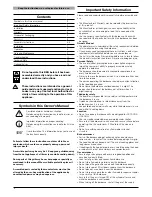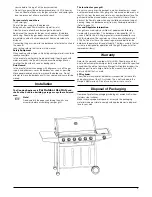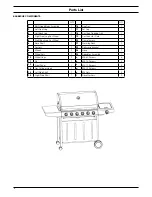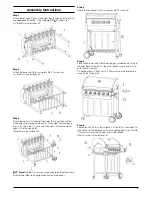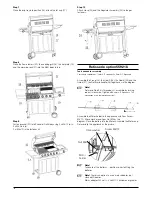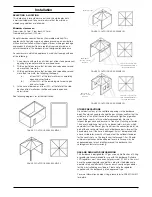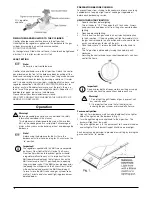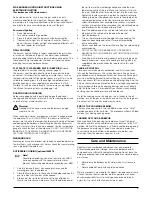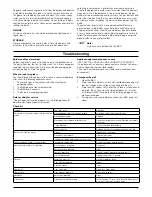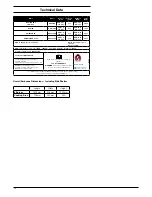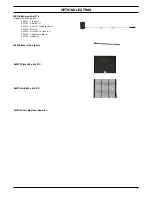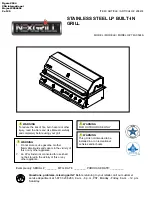
9
SIDE BURNER LIGHTING INSTRUCTIONS USING
ELECTRONIC IGNITION
(For barbecues with side burners)
Raise side burner lid. Push in and turn gas knob in an anti-
clockwise direction to the hi position. If burner does not light
immediately, turn the gas control knob to the off position and wait
one minute for any accumulated gas to clear off the grill.
For manual lighting
1. Raise side burner lid.
2. Turn control knob to high position.
3. Place a lit match near the burner until the burner ignites.
4. If burner fails to light, turn off and wait 5 minutes, then try
again. If burner still does not light after repeated attempts, call
your local dealer for assistance.
GRILL COOKING
The burners heat up the flame tamers underneath the grill, which
in turn heats the food on the grill. The natural juices produced
during cooking fall onto the flame tamers below and vaporise. The
subsequent rising smoke bastes the food, as it travels upwards,
imparting that unique barbecue flavour.
FLAT PLATE / FLAT-RIBBED PLATE / DEEP DISH
(where
supplied) Refer to cast iron cooking surfaces page 10.
The burners heat the plate directly, which then cooks the food
on contact. This allows for the cooking of smaller items, such as
seafood, which could fall through the spaces of a grill. This is also
suitable for cooking items that require high-temperature/short-
duration cooking, such as vegetables and smaller cuts of fish.
Similarly, this can be used in exactly the same way as a griddle in
the kitchen, for searing steaks, cooking eggs, etc.
ROASTING HOOD COOKING
Barbecues equipped with a roasting hood give the option of
cooking with hood closed to form an ‘oven’ for roasting food, such
as joints of meat, whole chickens, etc.
Warning!
Cooking with the hood closed and the burners on high
creates a fire risk.
When the hood is closed, a large amount of heat is trapped inside
the barbecue. Thus, it is IMPORTANT to make sure that all the
burners are turned to the low position to prevent burning of the food
and damaging the barbecue. Avoid lifting the hood unnecessarily
as heat is lost every time the hood is opened. Use the temperature
gauge to check the heat of the barbecue. DO NOT ALLOW YOUR
BARBECUE TO OVERHEAT. A BARBECUE SHOULD NEVER BE
LEFT UNATTENDED WHILE COOKING!
WARMING RACK
Warming racks are a convenient way to keep cooked food warm or
to warm items such as bread rolls. Always check that your warming
rack is properly fitted before use.
ROTISSERIE COOKING (optional) 559218
Note!
Should you decide to purchase a rotisserie, your BBQ
has been packed with the correct rotisserie motor
bracket. Follow the guide below for preparing your BBQ.
1. Carefully remove the cast iron cooking surfaces and the
warming rack from the barbecue.
2. Place the flame tamers to the centre of the barbecue body. It is
over this area that the meat will be cooked.
3. Slide one of the spit forks onto the spit rod and tighten its
thumb screw to secure it into place. Insert the pointed end of
the spit rod into the meat being cooked and slide the meat
towards the centre of the rod. Make sure the fork is fully into
the meat. Slide the other fork onto the rod, into the meat, and
tighten the thumb screw once in place. For optimal rotisserie
cooking, food must be placed securely onto the middle of the
spit rod and balanced so that the rotisserie can rotate freely
without interference from any barbecue surfaces. Any loose
sections of meat should be secured so they do not hang down
and interfere with the rotation of the spit rod.
4. Insert the pointed end of the spit rod into the motor. Lay the
other end of the spit rod onto the opposite bracket.
5. Light the barbecue.
6. Turn on the rotisserie motor to begin rotisserie cooking. The
hood has been designed so that it may be closed during
rotisserie cooking.
7. Always cook foods on the lowest flame setting to avoid burning
or overcooking.
8. DO NOT ALLOW YOUR BARBECUE TO OVERHEAT. A
BARBECUE SHOULD NEVER BE LEFT UNATTENDED WHILE
COOKING!
9. If cooking with rotisserie using indirect heat (not using burners
directly under meat - oven style cooking), a baking dish (not
supplied) can be placed under the food to catch fats and
drippings.
FLARE-UP CONTROL
Flare-ups occur when meat is barbecued, and its fats and juices
fall upon the flame tamers. The smoke from some flare-up helps
give cooked meat its barbecued flavour, but excessive flare-up will
result in meat being burned. To control flare-up, it is advisable to
trim away excess fat from meat and poultry before grilling. Also, the
burners should always be placed on the low setting during cooking.
Finally, extinguish flare-up by applying baking soda or salt directly
onto the flame tamers. Always protect your hands when handling
anything near the cooking surface of the barbecue.
If a fat fire should occur in the drip tray, turn all knobs to the off
position, turn off the gas at the bottle, and wait for the fire to go out.
Do not pull out the drip tray or douse with water.
END OF THE COOKING SESSION
After each cooking session, turn the BBQ burners to the “HIGH”
position and burn off for 5 minutes. This procedure will burn off food
residue, thus making cleaning easier.
TURNING OFF YOUR BARBECUE
When you have finished using your barbecue, turn off the gas at
the bottle and turn all the control valves fully clockwise to the “OFF”
position. Wait until the barbecue is sufficiently cool before replacing
the barbecue lid or closing its hood. Once cooled, a protective
cover should always be fitted to the barbecue to protect your
investment from the elements when not in use.
Care and Maintenance
Regularly clean your barbecue between uses and especially
after extended periods of storage. Ensure the barbecue and its
components are sufficiently cool before cleaning. Do not leave the
barbecue exposed to outside weather conditions or stored in damp,
moist areas.
•
Never douse the barbecue with water when its surfaces are
hot.
•
Never handle hot parts with unprotected hands.
Whilst our products are made to the highest standards and all care
is taken to make them as weather proof as possible, we cannot
accept responsibility for rust occurring on exposed metal parts
unless this is a result of faulty manufacture or parts.


